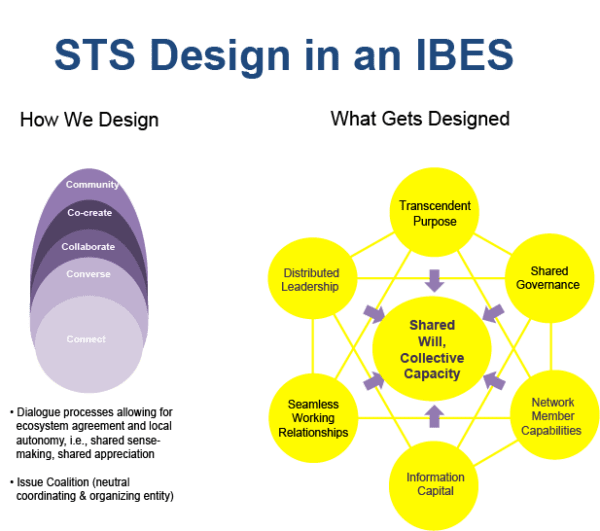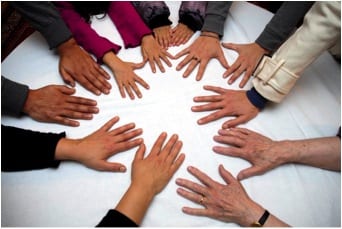Just as our global society appears to be coming together through shifting values and social paradigms so it appears to be coming apart at the seams with crumbling social institutions — government, education, healthcare, etc. Such duality of experience is part of the process when society finds itself in the midst of “fundamental and irrevocable” change agrees HBR blogger Nilofer Merchant. Through communities of purpose, proximity, passion, practice and providence, Merchant claims the emerging “social era will reward those organizations that understand they can create more value with communities than they can on their own.” Of course the proverbial question is, “How do we create these communities when we are still busy creating winners and losers in particular wars?”
Coming-into-unity requires a different set-up of beliefs (values) and behaviours (principles) than our more familiar practices of command and control, hierarchy (power ranking), centralized decision-making, competition, dominance, exploitation, protectionism, secrecy, fear. My community of practice, the Socio-technical Systems Roundtable (STS-RT), is grappling with this question as we reinvent and redesign our organization into an Issues-based Eco-system (IBES). Our innovation has led us to design the following dialogue processes necessary to achieve coming-into-unity: Connect + Converse + Collaborate + Co-create = Community©

In organizations and communities, ‘how we design’ and ‘what gets designed’ are key elements for maximizing collective capacity and establishing shared sense-making and shared appreciation.
On an individual basis, one’s participation in these communities of passion, practice or proximity requires similarly strong relationship building skills. Whether organization-to-organization or person-to-person, building collective capacity is a necessity in this New Normal environment of interconnected volatility, uncertainty, complexity and ambiguity. No one of us is as innovative and adaptive as all of us. We know diversity spawns creativity, but what we are just beginning to learn is that the people we attract into our lives (or who cross our paths) all have the potential to transform us. In Chapter 4 of my soon-to-be-published e-book, Creating Space — The Practice of Transformation, I fully support the belief that “all relationships are transformational.” In my own experience, each of my relationships presented opportunities for me to transform aspects of my being.
Typically, these transformational relationships whether supportive or destructive led to my conscious understanding of internal blockages preventing me from loving in more fulfilling ways. Of course, I had to choose to look with honesty into the mirror image reflected back by these individuals and in doing so I discovered who I see is me. I projected my perceptual filter (what I believed to be true about me) onto others including onto life’s events as demonstrated in the previous chapter by the Evolution of an Experience. I found if I liked another person, it was because what I saw in them was what I liked in me. If I did not like another person, what I disliked in them I disliked in me.
Our ability to attract each other (sibling, parent, lover, friend, child, enemy) is the first step (often unconscious) toward understanding why we are in relation to each other and who we are in each relationship. One of my favourite mantras, “the people I am looking for are looking for me,” helps remind me that like attracts like. Sometimes the likeness is our contribution or strength and sometimes it is our shared need or vulnerability. We are students and teachers of life and as such have much to share in and gain from discovering what our likenesses are.
Life always provides us with companions in each step along our journey. Our job is to ask, “What is the reason we are attracted to each other?”
To test this belief, select two relationships in your life — one loving and one stressful. Ask yourself the reason you are in each relationship. Why have you attracted each other? Your perception may not be shared by whom you selected so ask them the same question. In other words, the reasons for the two of you being in relationship may appear to be quite different on the surface. Dig deep until you understand what is important for you to learn from each other.
In the mirror of relationship, I have come upon three types of Way Show-ers (soul-based, seduction-by-admiration, and shadow-based), all equally important in their ability to reflect back my limitations and strengths. Of course, it is much more pleasurable and comfortable to connect around what we believe to be the positive aspects of ourselves (shared spiritual principles and values). It is often the Way Show-er soul-based relationships which form the foundation of our inner circle of loved ones. Sometimes we refer to these individuals as soul mates and have developed in-depth intimate friendships, partnerships or romantic bonds with them. An example of this type of relationship is typified with my friend, Maureen, whom I currently co-facilitate an awareness meditation, sharing and writing circle. To help you clarify the reasons you are in soul-based relationships, identify the people in your life fitting this category and state the reasons.
My Soul-based Relationships: Reasons:
1. ___________________________ _________________________________
_________________________________
_________________________________
2. ___________________________ _________________________________
_________________________________
_________________________________
3. ___________________________ __________________________________
__________________________________
__________________________________
My Pattern or Theme as Reflected in my Soul-based Relationships:
___________________________________________________________________________
___________________________________________________________________________
___________________________________________________________________________
Below is a partial list of characteristics I saw in my soul-based relationships and therefore in myself.

It is important for each of us to note what feelings are triggered when we apply these characteristics to ourselves. When I first considered the list as describing me, I felt as though I was being arrogant. It was difficult to claim such beauty existed within me. My inability to fully acknowledge my strengths came from believing messages like, “it’s rude to talk about yourself,” “people will think you are a braggart,” or “who do you think you are, someone special?” Those critical messages had the impact of limiting my ability to love myself.
Reread your own list and claim your true identity. Remember, who you see is you. If you do not have a smile on your face and a warm feeling of love in your heart by the time you finish, go back and read the list until you do. Let the “parts” of yourself come-into-unity.





